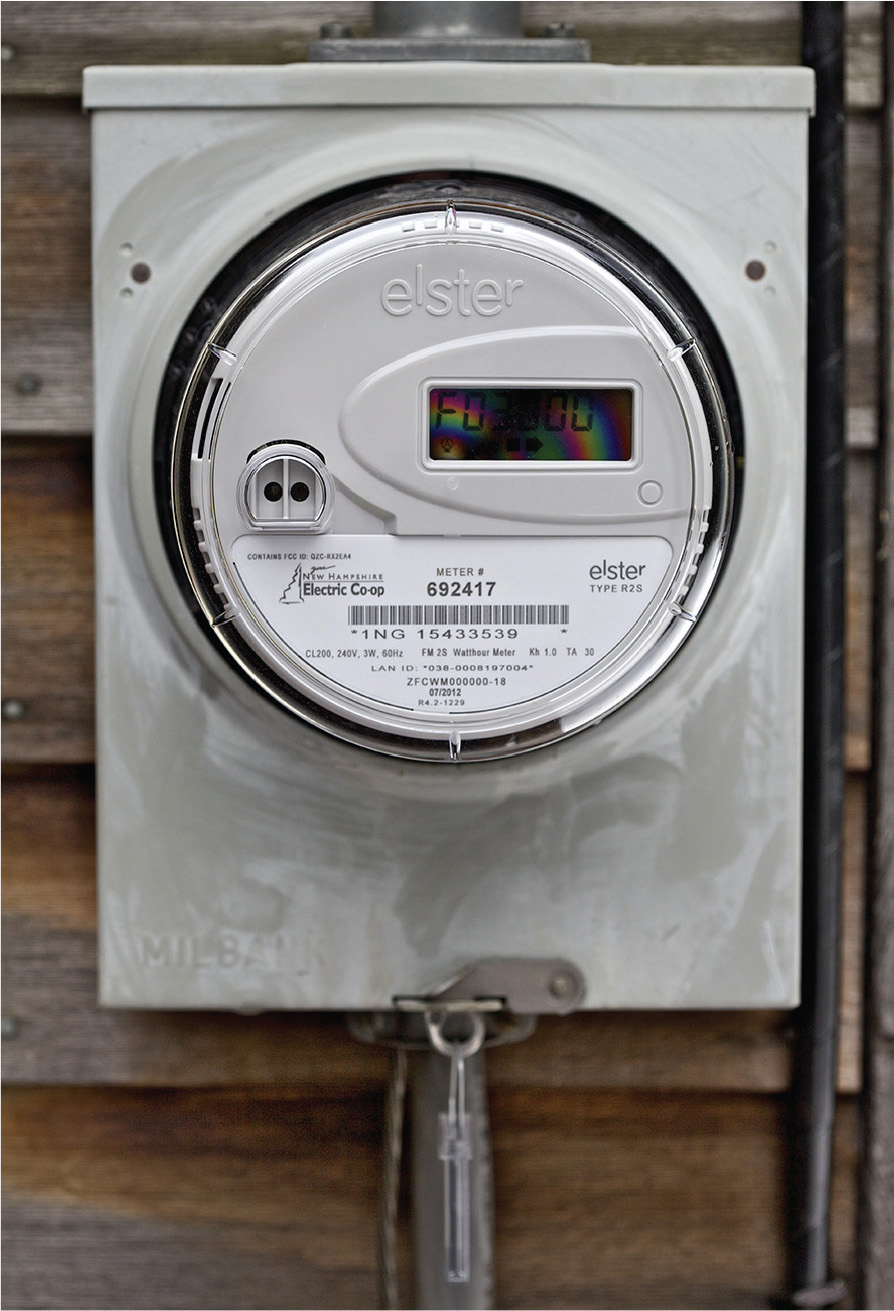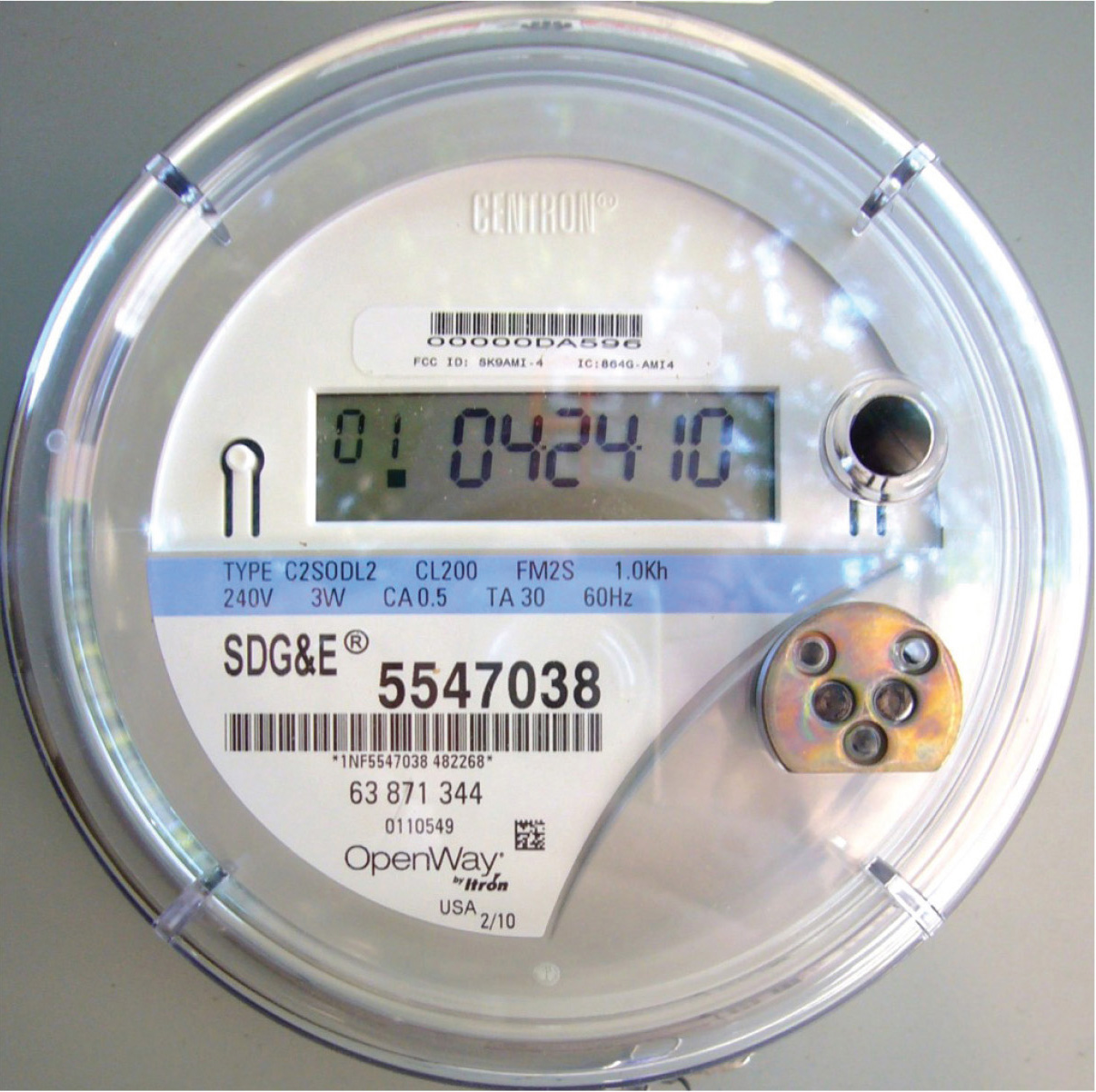CHAPTER 15
![]()
What Lies Ahead?
The utility meter reader, paying a quick visit once a month to every house on the street, is rapidly disappearing. Instead, a new type of meter has appeared. The smart meter, shown in Figure 15-1, inserts into the existing socket—so as far as installation goes, there is not too much to it. But this device has great hidden functionality, and ultimately, it may affect the way we live our lives because suddenly there is the potential for centralized control of virtually every home in the world.

FIGURE 15-1 This smart meter has a two-way wireless connection to the utility.
Electricity has become so much a part of every home and the lives of the people in it! Hand tools are becoming less essential. Even the hammer is powered by air, the compressor having an electric motor. We have telephones that take pictures and cameras that talk, all electrically powered.
There is no force on Earth that can compel you (the home crafter-electrician) to have a smart meter attached to your building, but then the utility can withhold electrical power from the substation, shown in Figure 15-2, from those who do not play according to their rules, as spelled out in the public utilities commission filings. The regulatory bodies are in the business of siding with the suppliers, not end users, of electrical power.

FIGURE 15-2 The substation is the source of local power, and the utility controls all lines that emanate from it.
At best, it is a standoff. Time, however, is not on the side of the utilities. This is so because the price of installed photovoltaic (PV) solar systems is in freefall. Solar cells, for the most part, are made of silicon, a very abundant element in the Earth’s crust. What accounts for the price of PV solar cells is the great number of operations that are required to create crystalline or thin-film silicon cells that are capable of generating electricity and exporting it into the outer world.
The stages in the manufacturing process have been simplified and automated so that the cost of solar PV cells in the form of panels, modules, and complete arrays has dropped dramatically, and there is every reason to believe that this trend will continue. A promising developing technology is building-integrated solar PV. Thin-film PV cells may be used to manufacture building-material units that have PV properties as well as comprising the wall and roof coverings. When and if this trend becomes a mature technology, electrical power generation will become decentralized. As things stand currently, utilities will not be out of the picture because cogeneration is still the most efficient means of energy storage. However, a further dynamic is at work. If utilities are compelled to buy surplus premises electricity at retail prices, faced with a diminishing market, they will be able to continue operating only at a substantial loss.
The situation will change abruptly if batteries are developed that are more efficient, longer lasting, and less expensive. Alternative methods for storing energy include, as we have noted, compressed air, water pumped to a higher elevation, and fuel cells running off of hydrogen that is manufactured by solar-derived electrolysis during daylight hours and stored in cylinders. These and other storage strategies show promise. At present, the impediment is high initial cost. This may drop as manufacturing techniques are refined. The fact is that we are obliged to move in some of these directions in order to reduce carbon emissions and restore the health of our planet’s atmosphere.
In my view, the home crafter-electrician can play a key role in all of this. We can build self-sustaining electrical systems that are independent of the grid, and in so doing, we can show our friends and neighbors that there is a better way.
In the past, the word smart was not generally attached to inanimate objects, but that is changing. Now there are smart buildings, smart telephones, and smart foods. Although they’ve been around for a few years, smart meters and the smart grid are gaining importance. In addition to the meter manufacturers and software providers who stand to profit from this implementation, the principal proponents are the utilities. They have a vested interest in expanding their infrastructure in the interest of increased efficiency and an enhanced balance sheet.
Smart Meter Anatomy
Early (i.e., nonsmart) electric meters worked in a variety of ways. The first arc lamps for street lighting were connected in series, and all went on and off simultaneously, so it was necessary only to clock the hours of usage and compute the electric bill accordingly. Thomas Edison’s parallel-connected direct-current (dc) filament lamps were individually switchable, so a more sophisticated solution was required. Edison, always a chemist, built a metering device that consisted of an insulated vessel containing zinc plates hooked in parallel with each customer’s premises wiring. Utility workers weighed the electrodes to determine the monthly bill. This method was not very accurate, so it was soon replaced by a motor-driven meter.
With the implementation of George Westinghouse’s alternating-current (ac) electrical system, it became apparent that two opposite-phase ac fields could cause an armature to turn. This became the basis for the watt-hour meter that remained in use for over 100 years.
In the 1930s, electrical codes were revised to allow meters to be connected upstream from the main disconnect and overcurrent devices. This, along with socket-mounted sealed units, made customer tampering less likely. For ease of reading, meters were located outside. A gear train with a 1-to-10 ratio conforming to our digital numbering system made meter reading easy once you got past the clockwise/counterclockwise shift between adjacent digits. Since 1990, the four major meter manufacturers (i.e., Landis+Gyre, General Electric, Itron, and Elster) have offered fully electronic models without moving parts. A fully electronic smart meter with wireless connection to the utility is shown in Figure 15-3.

FIGURE 15-3 The new smart meter plugs into the existing meter socket, with no additional wiring required.
These meters remain widely used today. An important variation is the torroidal coil, a current transformer that senses current flow by means of magnetic flux variations. In heavy-load applications, such as large industrial facilities, this mechanism simplifies wiring and hardware requirements. Overall, the traditional electromechanical meter has worked well for utilities, customers, and electricians. Individual utility policies determine the point of connection, which varies depending on whether the service is aerial or underground. The electrician installs the service conductors and equipment downstream from the point of connection. The utility may or may not supply the meter socket.
For an underground service lateral, typically the customer (or the electrician) furnishes the conduit, usually polyvinyl chloride (PVC), buried, backfilled, and graded. The utility furnishes the wire upstream from the meter because it would not be appropriate to have nonutility workers climbing the pole and connecting to the transformer.
With the advent of the smart meter, most of these procedures remain unchanged. But depending on its features, a smart meter, for full implementation, implies the use of smart appliances and home automation. Electricians will be the big players in this arena if the homeowners and maintenance departments are unable or unwilling to undertake this work. Moreover, the very fact that home and commercial building owners are becoming more energy aware will mean that they will look for other ways to upgrade their electrical systems in the interest of lowering their electric bills. Electricians can speak knowledgeably about the benefits of good grounding and adequate wire sizing. Poor grounding means out-of-balance legs so that some motors will run below rated voltage, drawing increased current. Moreover, as the years go by, motorized tools and appliances begin to draw more current, producing heat in place of torque. In an industrial facility, significant capital can be conserved by replacing outmoded motors and lighting. The shift to T-8 fluorescent bulbs and ballasts saved large facilities many thousands of dollars annually. On the horizon are light-emitting diodes (LEDs), an enormous improvement in terms of energy use when and if the initial installation cost comes down. In many locations, utilities offer incentives for large customers to improve their power factor by installing capacitors. Power quality is a key consideration in large industrial facilities that are heavily motorized. You can pay for that top-of-the-line oscilloscope by using it to find harmful harmonics that are affecting power consumption and motor life. The smart meter will provide a starting point for this and similar endeavors. These are jobs for the electrician that may result from smart meter installation.
Smart meters work in close to real time to read premises sensors, report power outages, and detect power quality issues. They go way beyond the traditional interval and time-of-use meters that have been around for a quite a few years. An older technology involved the installation of two meters on the outside of a building. One was wired to the entrance panel, whereas the other was wired, through a sealed enclosure containing a 24-hour timer, to the hot-water heater. The idea was that the hot-water heater was powered down during peak usage hours, enabling the utility to distribute its load more evenly. In return for agreeing to this arrangement, the customer was billed at a lower rate for power measured by the second meter. The basic paradigm was that everyone benefited—utility, customer, and our planet—due to reduced carbon usage and less global warming. The problem, however, was that the equipment was more costly than the energy savings warranted, so this dual-meter arrangement has fallen into disuse.
Utilities pay an average of $200 per smart meter, but this figure varies widely depending on buyer, seller, and number of units purchased. For those among us who are interested in such things, it is instructive to take a look at the inner workings of a typical smart meter manufactured by Elster. Needless to say, the unit is not cord-and-plug connected. Two large copper conductors rated at 200 amps are connected to the input and output lugs of a conventional meter socket. Rather than powering an old-world motorized gear train, these conductors are inductively coupled to current transformer windings, whereby a small current is sampled periodically in order to develop the digital information that is transmitted to the utility. Additionally, a small portion of the 240-volt, 60-Hz supply is stepped down to 10 volts, which is subsequently rectified to provide dc bias for the many integrated circuits that populate a printed circuit board. The smart meter has a local-area network (LAN) ID number so that it can be recognized to participate via the Internet Protocol with the EnergyAxis Smart Grid network.
Smart meters probably will gain in functionality as quickly as utility engineers and meter manufacturers can think of new uses. The basic idea is that the smart meter delivers information to both the energy provider and the end user. Both ends of the supply chain, it is stated, will become more efficient, meaning that less energy will be expended to provide more of the benefits we have come to expect. The two parts of the equation are improved decision making by consumers regarding their energy use and more effective management of the grid by providers. The smart grid and smart meter presuppose one another and are codependent.
It was not always this way. In simpler times, the smart grid consisted only of a Supervisory Control And Data Acquisition (SCADA)–enabled information network that aided in maintenance and control of utility-owned substations. This protocol increased efficiency and lessened downtime, but there was no interactivity with customer-owned equipment beyond monthly visits by the meter reader. This is changing rapidly.
Smart meters are similar in appearance to their traditional counterparts, although the curved-glass body that protrudes from the meter socket is replaced by a clear plastic housing with a flat face at the front through which a digital display may be viewed. Internally, there is a radio transmitter, with an internal (or in special cases external) antenna. Typical operation is in the 902- to 928-MHz frequency band in short millisecond pulses. Power consumption is monitored at 15-minute intervals or less, and the information as reported to the utility may be made available to the consumer either online or by means of a control panel installed in the customer’s home or place of business. Using this information, the customer can fine-tune appliance usage to minimize consumption during peak periods and reduce the electric bill while helping the utility to even out harmful demand cycles. Moreover, the meter can detect and report outages and aberrations, even functioning as an arc-fault detector for the entire premises.
These benefits are palpable, and everyone stands to gain. The fact is, however, that utilities and manufacturers have been confronted by an enormous amount of opposition on the part of an aroused public, and the answers they have provided have not been satisfactory from the point of view of opponents. Objections fall into several categories:
• Health. Long-term exposure to any electromagnetic field (EMF) is seen by smart meter opponents as a health hazard. Numerous studies have supported this point of view, whereas others have countered that the level and duration of exposure are minimal, the danger further mitigated by the fact that the meter is outside. But what about the child who sleeps inside next to the exterior wall just inches from the meter? It seems that for every assertion, there is a counter argument, so we can only say that the jury is out on this one.
• Privacy. Two issues are relevant. The smart meter, like some other electrical distribution equipment, is located on the customer’s property. Notwithstanding any legal easements that may exist, bringing in a new technology against the desire of a owner is invasive to say the least. Moreover, this equipment reports activities of the residents to the utility, and these residents have no way to know how this information will be shared. This may not be an issue to you or me, who may have no secrets, but for some, it is an invasive infringement, and the right to privacy for these individuals should not be violated. Additionally, what are the implications of the remotely controllable kill switch?
• Fire hazard. It is contended that the smart meter constitutes a palpable fire hazard. This could be true if it is installed incorrectly, but this is true of other electrical equipment as well. But there have been documented instances of this complex instrument overheating and posing a fire risk.
• Centralized power generation. Opponents argue that the installation of vast numbers of expensive smart meters further commits us to the idea of centralized power generation, along with a continuing stake in conventional fossil fuel use and associated planetary warming. Moreover, it is asserted that utility rates inevitably will rise to pay for this vast implementation, which is unlikely to be offset by the small effect it will have on peak usage.
• Vulnerability to cyber attack. Radio-controlled customer access to the grid, it is argued, makes us increasingly vulnerable to cyber attack. Just as hackers have shrugged off conventional password protection, so hostile political entities or terrorist organizations could exploit vulnerabilities in the North American grid. Smart metering, if it becomes universally adopted, could be a way in. Data hacking, introducing malware into the system, and other attacks at the grid end could shut off the lights.
At one time, the biggest threat was that dishonest customers would attempt to steal power by inverting the old-style meter, deploying strong magnetic fields near the meter, and similar stratagems. Now the danger is that, for whatever reasons, hostile organizations would attempt to compromise the grid so that a large geographic area would be without power, and data transfer would be hampered.
Software providers are attempting to develop security against unauthorized changes in cybernetic configurations in the hope of making the grid more secure and reliable. It is uncertain at this time which side will prevail. The smart meter–grid combination could turn out to be a valid defense against cyber attack or, as a worst-case scenario, a vulnerable point of entry for a destructive assault.
